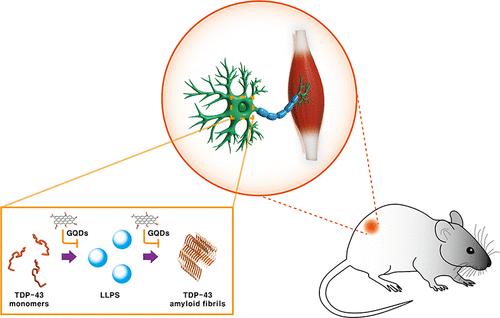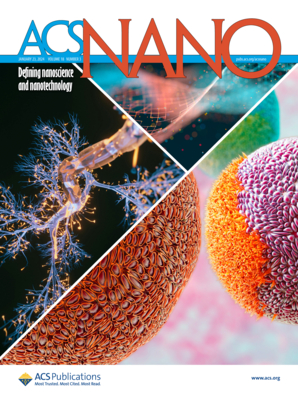Graphene Quantum Dots Attenuate TDP-43 Proteinopathy in Amyotrophic Lateral Sclerosis
IF 15.8
1区 材料科学
Q1 CHEMISTRY, MULTIDISCIPLINARY
引用次数: 0
Abstract
Aberrant phase separation- and stress granule (SG)-mediated cytosolic aggregation of TDP-43 in motor neurons is the hallmark of amyotrophic lateral sclerosis (ALS). In this study, we found that graphene quantum dots (GQDs) potentially modulate TDP-43 aggregation during SG dynamics and phase separation. The intrinsically disordered region in the C-terminus of TDP-43 exhibited amyloid fibril formation; however, GQDs inhibited the formation of amyloid fibrils through direct intermolecular interactions with TDP-43. These effects were accompanied by attenuation of the ALS phenotype in animal models. Additionally, GQDs delayed the onset and survival of TDP-43 transgenic mouse models by enhancing motor neuron survival, reducing glial activation, and reducing the cytosolic aggregation of TDP-43 in motor neurons. In this research, we demonstrated the efficacy of GQDs on the SG-mediated aggregation of TDP-43 and the binding property of GQDs with TDP-43. Additionally, we demonstrated the clinical feasibility of GQDs using several animal models and other types of ALS caused by FUS and C9orf72. Therefore, GQDs could offer a new therapeutic approach for proteinopathy-associated ALS.

求助全文
约1分钟内获得全文
求助全文
来源期刊

ACS Nano
工程技术-材料科学:综合
CiteScore
26.00
自引率
4.10%
发文量
1627
审稿时长
1.7 months
期刊介绍:
ACS Nano, published monthly, serves as an international forum for comprehensive articles on nanoscience and nanotechnology research at the intersections of chemistry, biology, materials science, physics, and engineering. The journal fosters communication among scientists in these communities, facilitating collaboration, new research opportunities, and advancements through discoveries. ACS Nano covers synthesis, assembly, characterization, theory, and simulation of nanostructures, nanobiotechnology, nanofabrication, methods and tools for nanoscience and nanotechnology, and self- and directed-assembly. Alongside original research articles, it offers thorough reviews, perspectives on cutting-edge research, and discussions envisioning the future of nanoscience and nanotechnology.
 求助内容:
求助内容: 应助结果提醒方式:
应助结果提醒方式:


